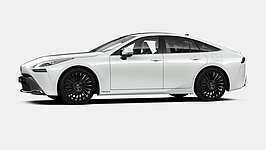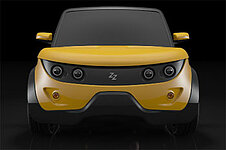E-vehicle
Electified vehicles workspace objective
The workspace dedicated to the electrified vehicle section allows for testing with various drivers. The entire fleet is instrumented in a non-intrusive manner, enabling the vehicles to maintain their original form while being tested by different drivers. The collected data allows for the study of various factors such as energy consumption, driving behaviors, and, for example, the examination of aspects related to the acceptability of battery-powered vehicles.
- Nissan Leaf (electrical battery vehicle)
- Toyota Mirai (hydrogen fuel vehicle)
- Tazzari Zero (electrical battery vehicle - lightweight quadricycle)
The vehicle aspect is directly linked to other activities, such as driver-in-the-loop simulation for driving simulations, as well as power hardware-in-the-loop simulation for testing systems like inverters, electric machines, and batteries. This approach allows for a holistic understanding of the entire chain, enabling alignment between real vehicle performance, simulation, and component testing.
Recording Data for Battery and Hydrogen Fuel Cell Electric Vehicles via OBD Port for Experimental - Simulation Comparison:
In the dynamic landscape of electric vehicles (EVs), both battery electric vehicles (BEVs) and hydrogen fuel cell electric vehicles (FCEVs) are at the forefront of sustainable mobility. To delve deeper into their real-world performance, we employ a cutting-edge approach by recording crucial data through the On-Board Diagnostics (OBD) port. This initiative allows us to bridge the gap between experimental findings and simulation results, providing a comprehensive of the propulsion systems. The OBD port, a standardized interface in modern vehicles, serves as a gateway to accessing real-time data generated by the vehicle's electronic control unit (ECU). For battery electric vehicles, this includes information on battery state-of-charge, voltage, and current, while hydrogen FCEVs provide insights into fuel cell operation, hydrogen consumption, and overall system diagnostics.
Our data recording methodology involves integrating advanced data loggers and sensors to capture a multitude of parameters during real driving sessions. The recorded data is then meticulously analyzed and compared with simulation results. This comparative analysis enables us to validate the accuracy of our simulation models and refine them (Fig 1.). It also facilitates the identification of discrepancies between theoretical projections and actual on-road performance, leading to valuable insights for optimization.
The overarching goal is to improve the efficiency, reliability, and range of both battery and hydrogen fuel cell electric vehicles. By aligning experimental and simulated data, we aim to create a feedback loop that informs the iterative development of vehicle technologies. This iterative process is pivotal in advancing the adoption of electric and hydrogen-powered propulsion systems, ensuring they meet the evolving demands of sustainable transportation. In essence, the integration of OBD data recording for battery and hydrogen fuel cell electric vehicles represents a holistic approach to research and development, fostering innovation and contributing to the ongoing evolution of clean and efficient mobility solutions.

Display the architecture implemented for the instrumentation between the dSPACE board, the inertial measurement system, supervision and data storage

Shows the Nissan Leaf car available on eV platform
| Vehicle model | Nissan leaf 2 |
|---|---|
| Vehicle Type | Battery Electric Vehicle (BEV) |
| Range (approx.) | 250 km |

| Vehicle model | Toyota Mirai |
|---|---|
| Vehicle Type | Hydrogen Electric Vehicle |
| Range (approx.) | 650 km |

| Vehicle model | Tazzari Zero |
|---|---|
| Vehicle Type | Battery Electric Vehicle |
| Range (approx.) | 70 km |
Contact
Prof. Alain Bouscayrol,
Alain.Bouscayrol@univ-lille.fr,
University of Lille
Project linked to Vehicle
SARA: Social Acceptance of electric vehicles in Restricted Areas
The team of the CUMIN research program is looking for volunteers to take part in the test of an electric car. During the test you will be asked to answer questions about your mobility practices (commuting trips) and your perception of electric mobility*. The results will make possible to better identify the challenges of accessibility to sustainable mobility. If you have time to devote to us from January, 30 to May, 8 2024 (Monday to Thursday, between 9:30 a.m. and 3:00 p.m.) to both answer our questions and try an electric car on the Cité Scientifique Campus, you can register for a test drive by clicking on this link:
https://evento.renater.fr/survey/essai-ve-test-xviadtl3 (Fig 1.)
Please note that the test may take up to 1 hour maximum.
Thank you in advance for your participation and of course a driving license is mandatory! We are at your disposal to answer your questions
(lucie.juncker@univ-lille.fr)
Lucie Juncker - L2EP/TVES CUMIN project engineer.
*The survey is submitted to the General Data Protection Regulation 2024-10.

Display QR code for test registration and test period
